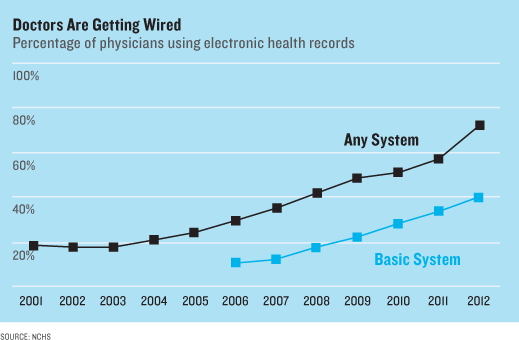- mobile technologies improve outcome measures associated with exercise interventions when compared to those interventions alone
- not definitive, but certainly encouraging
Abstract: http://www.biomedcentral.com/1471-2458/13/1051/abstract
Provisional paper (PDF): Lifestyle interventions
mHealth improves risk profile in cardiovascular disease, type 2 diabetes patients
November 8, 2013 | By Greg Slabodkin
A provisional article published in the peer-reviewed journal BMC Public Health suggests that mHealth technology supporting exercise prescription interventions can be effective.
The findings are based on a Canadian study of 149 adults with at least two metabolic syndrome risk factors, one group using the intervention and one control group.
“Mobile health technologies have proved to be a beneficial tool to achieve blood pressure and blood glucose control in patients with diabetes,” argue the authors, who are currently completing their analyses and will be submitting their data for publication in the next few weeks. “These technologies may address the limited access to health interventions in rural and remote regions. However, the potential as a tool to support exercise-based prevention activities is not well understood.”
The study was undertaken to “investigate the effects of a tailored exercise prescription alone or supported by mobile health technologies to improve metabolic syndrome and related cardiometabolic risk factors in rural community-dwelling adults at risk for cardiovascular disease and type 2 diabetes,” states the article. The authors hypothesized that the primary outcome, systolic blood pressure, and secondary outcomes would be improved in both groups, but to a greater extent in the mobile health intervention group at 12 weeks and that these changes would be better maintained at 24 and 52 weeks in the intervention group with mobile health support, compared with the active control group.
The results of the study “will contribute to the current literature by investigating the utility of mobile health technology support for exercise prescription interventions to improve cardiometabolic risk status and maintain improvements over time, particularly in rural communities,” concludes the provisional article, which serves as a protocol paper.
Study participants were recruited from rural communities in Ontario, Canada. Participants were randomized to either: an intervention group receiving an exercise prescription and devices for monitoring of risk factors with a smartphone data portal equipped with a mobile health application; or an active control group receiving only an exercise prescription.
In addition to the exercise prescription, the intervention group received a mobile health technology kit for self-monitoring of biometrics and physical activity. The kit included a smartphone (Blackberry Curve 8300 or 8530) equipped with Healthanywhere health monitoring app (Biosign Technologies), a Bluetooth-enabled blood pressure monitor (A & D Medical), a glucometer (Lifescan One Touch Ultra2) with Bluetooth adapter (Polymap Wireless) and a pedometer (Omron).
Nevertheless, a recent study in the Journal of Medical Internet Research found that although mobile health interventions are effective in promoting physical activity, their degree of validity reported in studies is unclear.
Using the RE-AIM (reach, effectiveness, adoption, implementation, and maintenance) framework, the review revealed a recent increase in studies conducted to determine the effectiveness of mHealth interventions for the promotion of physical activity. Yet, quantity, not quality, seems to prevail, the authors argued.
To learn more:
– read the article in BMC Public Health




